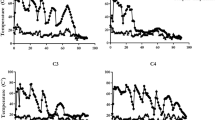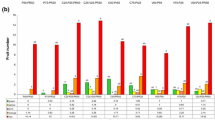Summary
The effect of peat and grit on the physical properties of composts made from soils of different structural properties has been examined. Peat was beneficial in giving improved physical properties to the composts, better vegetative growth of tomato and Antirrhinum and also earlier flowering with tomato. It had, however, no significant effect on the total yield of tomato fruit. Peat also eliminated a sterilizing toxicity in a chalky boulder clay.
Measurement of macro-pore volume gave the best physical assessment of the mixtures with respect to vegetative growth, but the extent to which the improved growth was dependent on the physical property or to some inherent property of the peat has not been determined.
Grit was not such a good physical conditioner from either a plant growth or physical point of view as peat. The size of the grit over the range 0.5–1.0 to 3.0–5.0 mm did not cause any significant change in the physical properties of mixtures when used in the proportions 60 soil, 25 well-granulated peat, 15 grit.
Similar content being viewed by others
References
Baker, K. F., The U.C. system for producing healthy container-grown plants. Calif. Univ. Agr. Exp. Sta. Manual23 (1957).
Baver, L. D., Soil Physics, 2nd. ed. J. Wiley & Sons, Inc. N.Y.
Brase, K. D., Root growth and flower production of roses in soil and soil and peat mixtures of varying moisture contents. Proc. Am. Soc. Hort. Sci.37, 963–966 (1939).
British Standards Institution. Methods of test for soil classification and compaction. British Standards1377, 27–28 (1948).
Croney, D., Coleman, J. D., and Bridge, P. M., The suction of moisture held in soil and other porous materials. Road Research Tech. Paper24, 5–8 (1952).
Fruhstorfer, A., Die Entwicklung der Einheitserde. Gartenwelt52, 270–271 (1952).
Lawrence, W. J. C., and Newell, J., Seed and Potting Composts (Revised 4th edition) 51–54 (1950).
Longley, L. E., The value of peat in a potting mixture. Proc. Am. Soc. Hort. Sci.32, 639–644 (1934).
McCool, M. M., Value of peats for mineral soil improvement. Contrib. Boyce Thompson Inst.4, 245–255 (1932).
Ray, S. H. and Shank, J. B., The aggregation and aeration of some greenhouse soil mixtures for roses and carnations. Proc. Am. Soc. Hort. Sci.49, 420–426 (1947).
Wild, E. I., The effect of different soil media on the production of flowers of Better Times roses. Proc. Am. Soc. Hort. Sci.37, 942–944 (1939).
Author information
Authors and Affiliations
Rights and permissions
About this article
Cite this article
Bunt, A.C. Some physical properties of pot-plant composts and their effect on plant growth. Plant Soil 13, 322–332 (1960). https://doi.org/10.1007/BF01394644
Received:
Issue Date:
DOI: https://doi.org/10.1007/BF01394644




